Abstract
OBJECTIVE: To provide clinicians with a critical evaluation of citalopram, a selective serotonin reuptake inhibitor (SSRI) that has been available in Canada since March 1999. DATA SOURCES: Commercial searches (MEDLINE and BiblioTech) and an "in-house" search (InfoDrug) were used to find published English-language references for clinical and preclinical publications. There was no restriction of publication dates. Primary index terms used were: pharmacological properties, receptors, pharmacological selectivity, pharmacokinetics, age-related pharmacokinetics, sex-related pharmacokinetics, renal dysfunction, hepatic dysfunction, cytochrome activity, drug interactions, adverse reactions, antidepressant switching, precautions, overdose, drug discontinuation, children, geriatric, depression, combination therapy, placebo control, refractory depression, anxiety disorders and medical disorders. STUDY SELECTION: A total of 74 studies were reviewed. Twenty-one of these studies specifically examined the clinical efficacy and tolerability of citalopram in depressive disorders as well as other disorders. In depressive disorders, clinical studies were required to have either placebo or active comparison controls for a minimum of 3 weeks. For other disorders, in the absence of double-blind trials, open-label studies were included. Pharmacological studies were limited to animal studies focusing on citalopram's selectivity and receptor specificity, and positron emission tomography studies were incorporated to include human pharmacological data. Pharmacokinetic studies focused on the metabolism, safety and tolerability of citalopram, specifically with reference to adverse reactions, drug interactions and overdose in addition to citalopram's effect on vulnerable populations, such as children, the elderly and patients with metabolic diseases. DATA EXTRACTION: Data on clinical studies were summarized according to test measures, study duration and outcome of study. Pharmacokinetic and pharmacodynamic studies were summarized according to properties and interactions. Adverse reactions were extracted to outline citalopram's safety profile. DATA SYNTHESIS: Citalopram is an SSRI antidepressant with a more specific and selective pharmacological profile than other antidepressants of its class. It is well tolerated, and drug interactions are not a significant concern. It is also reasonably safe for populations vulnerable to pharmacokinetic effects, such as the elderly and patients with metabolic diseases. In addition to its tolerability, citalopram is effective in the treatment of major depression, other depressive disorders and panic disorder. It has the potential to effectively treat other anxiety disorders and substance-use disorders; in addition, it may be useful in several medical conditions. CONCLUSIONS: There is evidence to support the role of citalopram as a well-tolerated and effective SSRI antidepressant. There is a need for further evaluation of its role in psychiatric disorders other than major depressive disorder.
Full text
PDF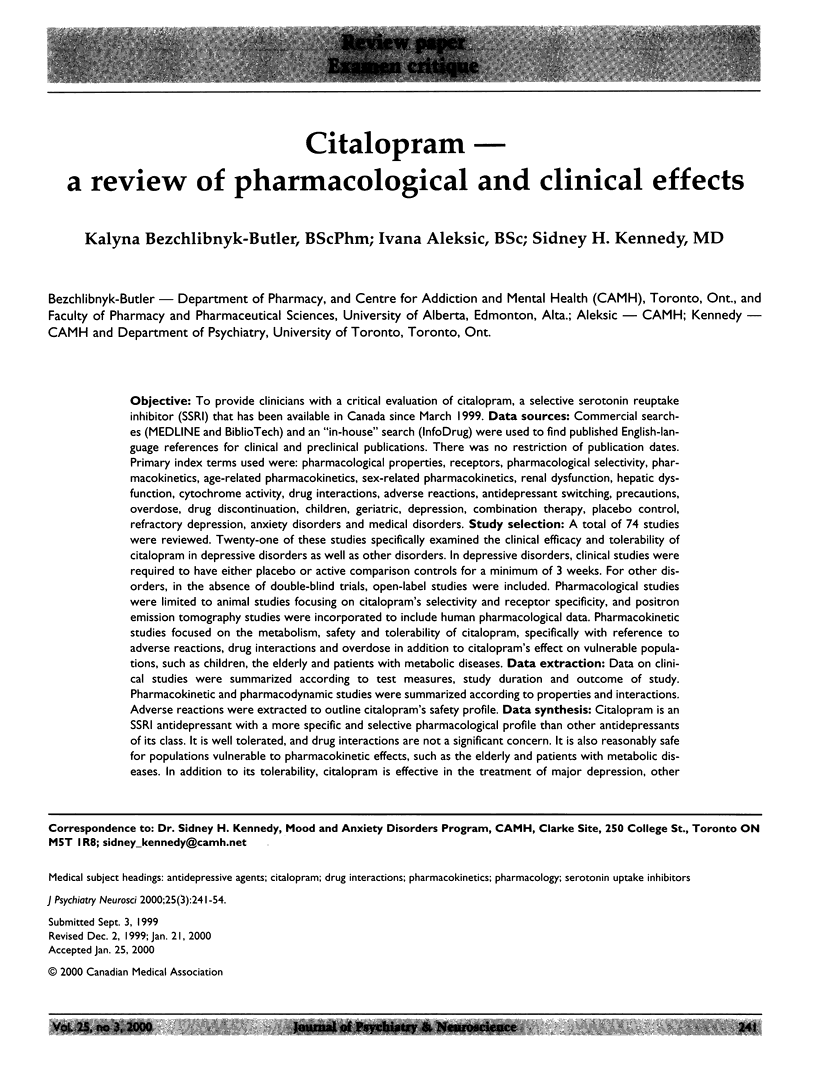
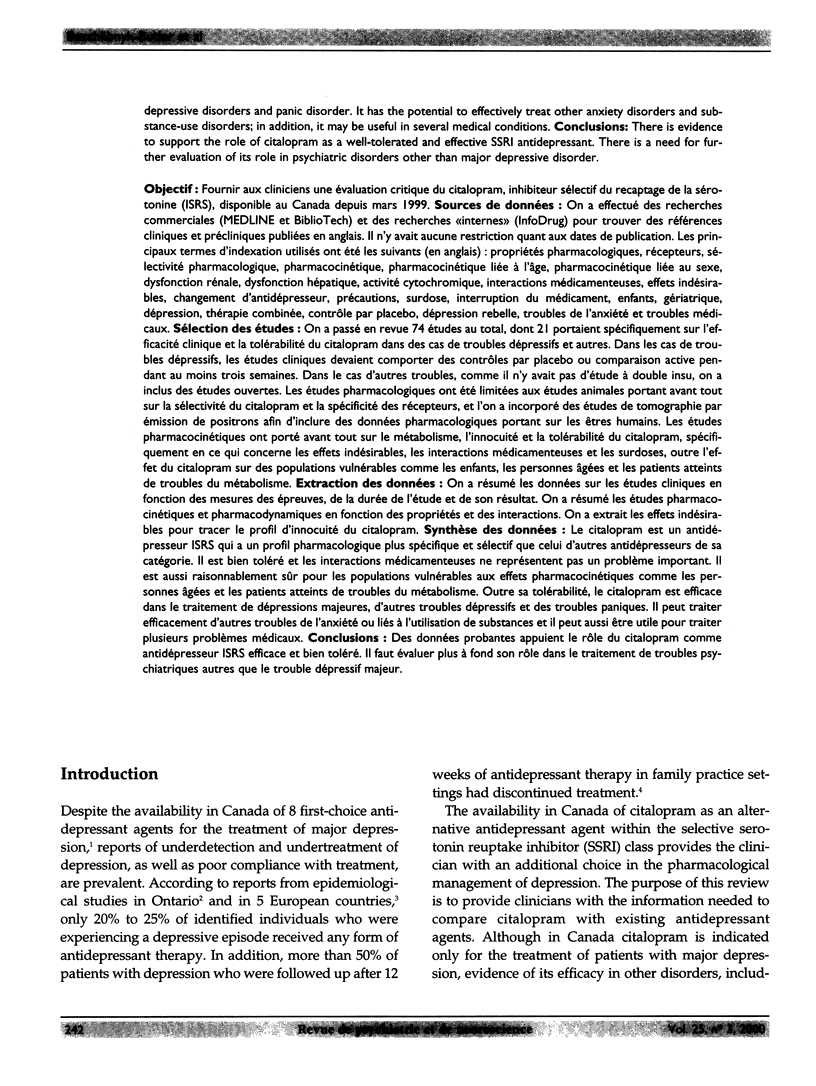
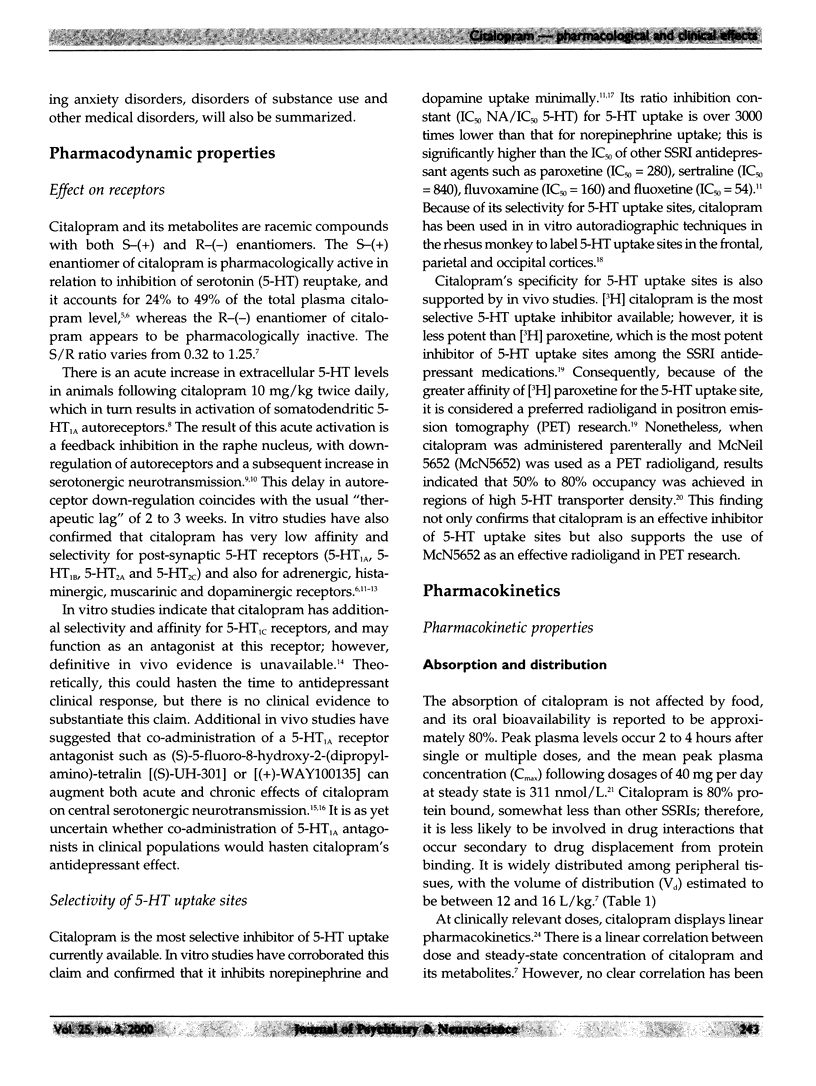

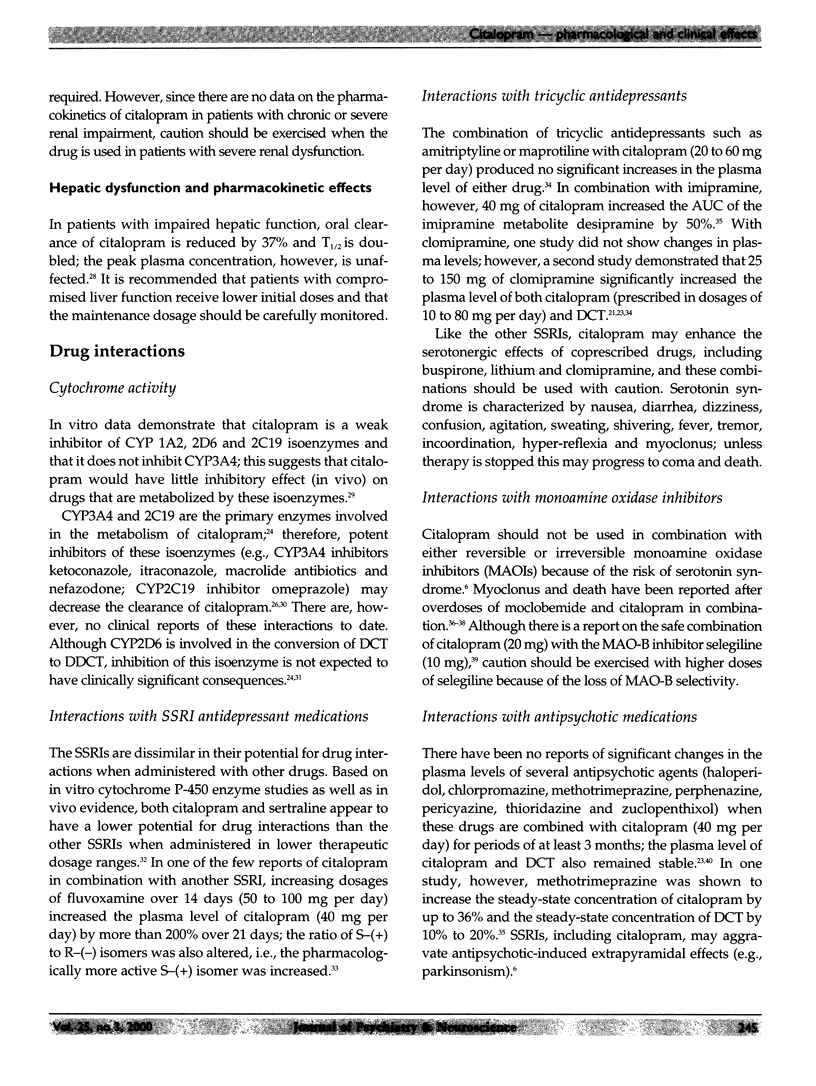
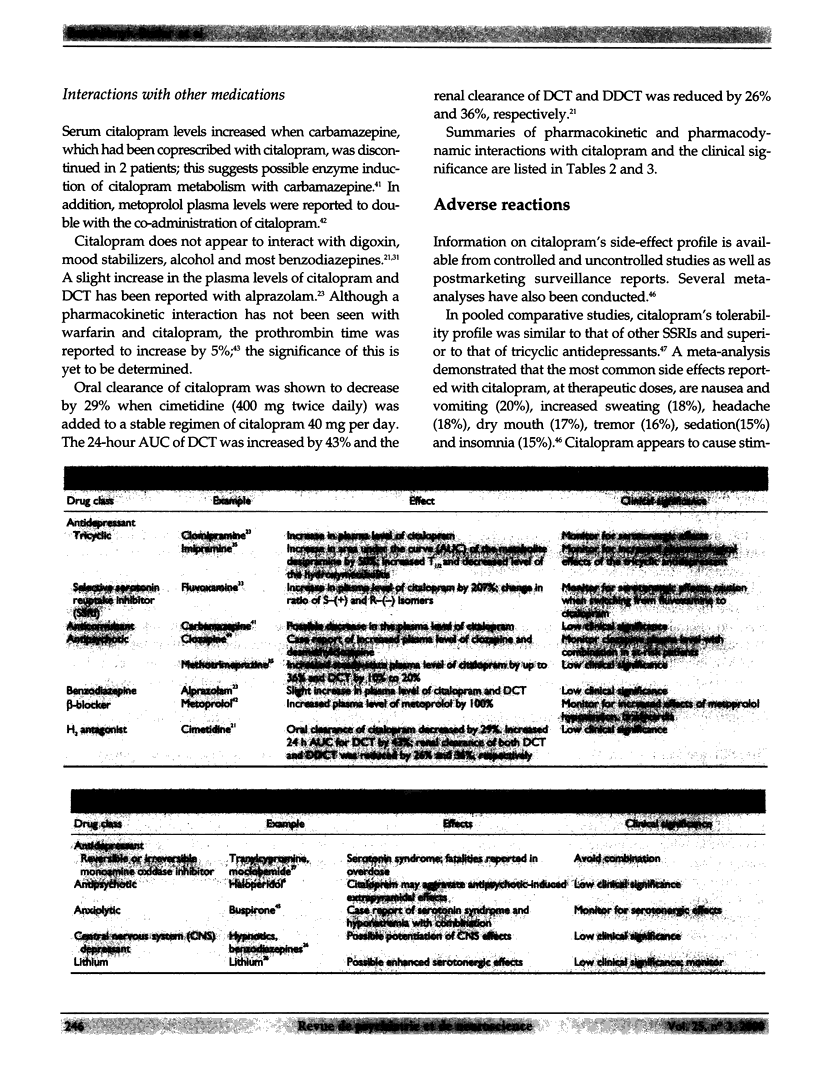
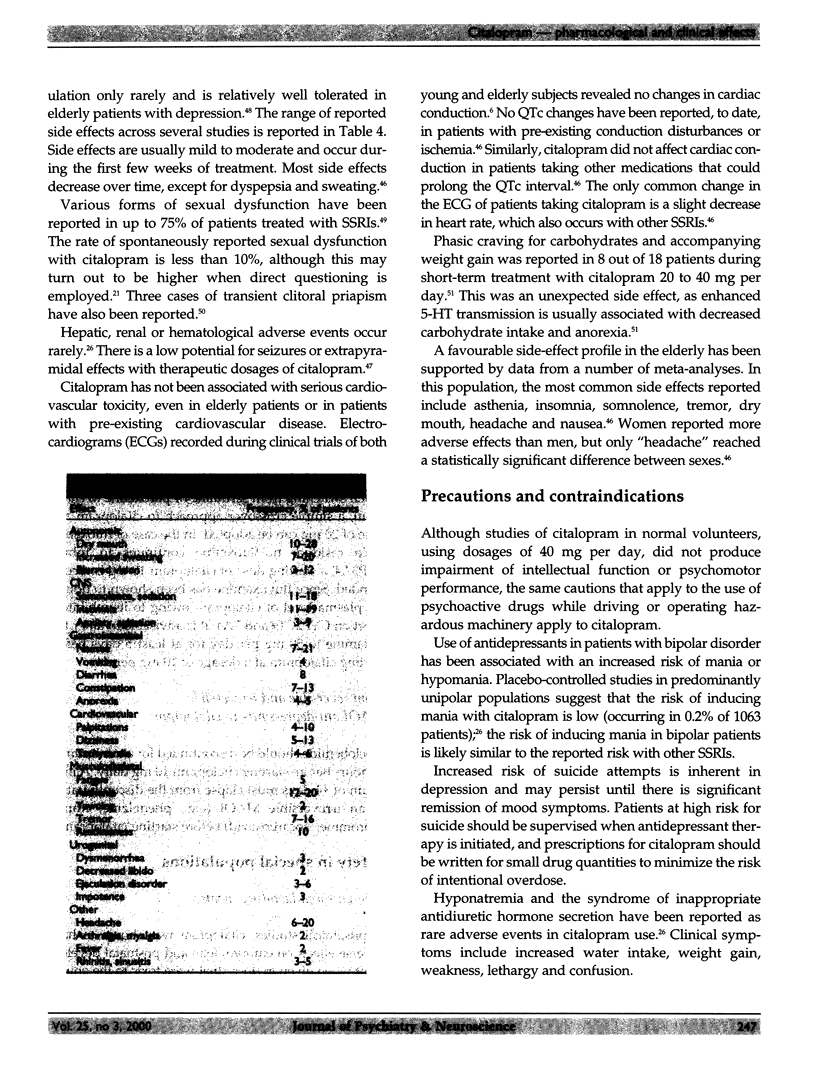
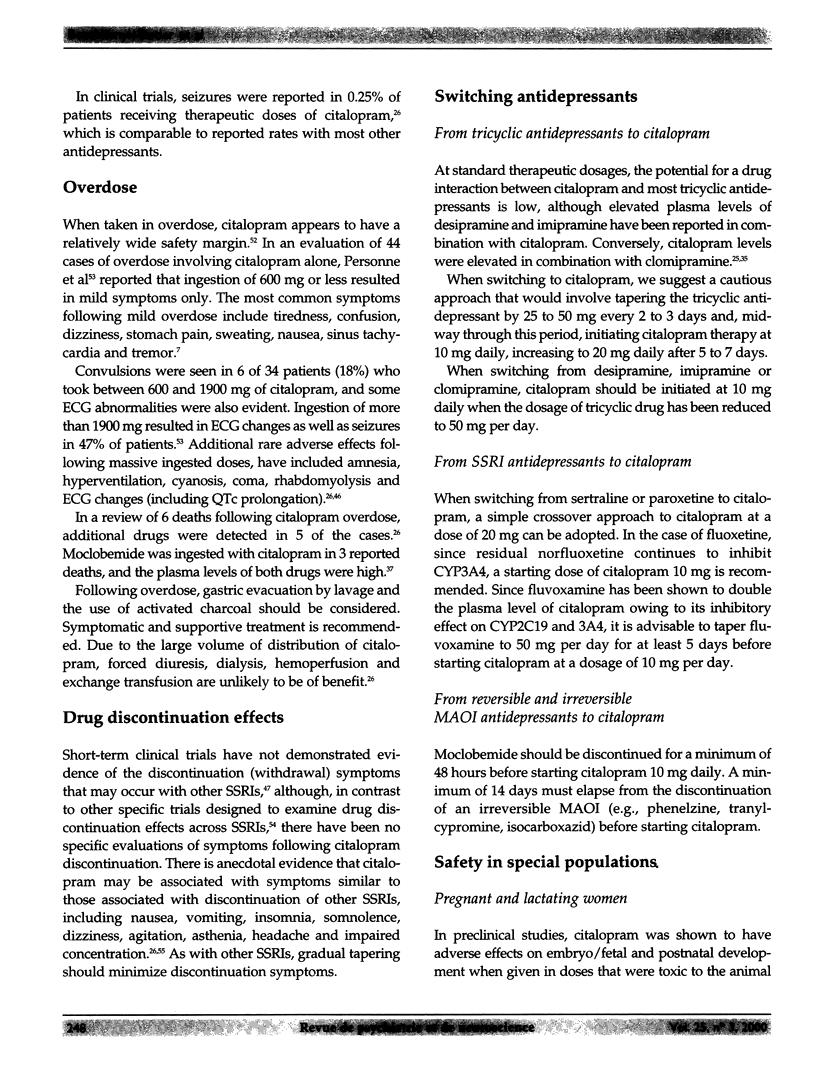
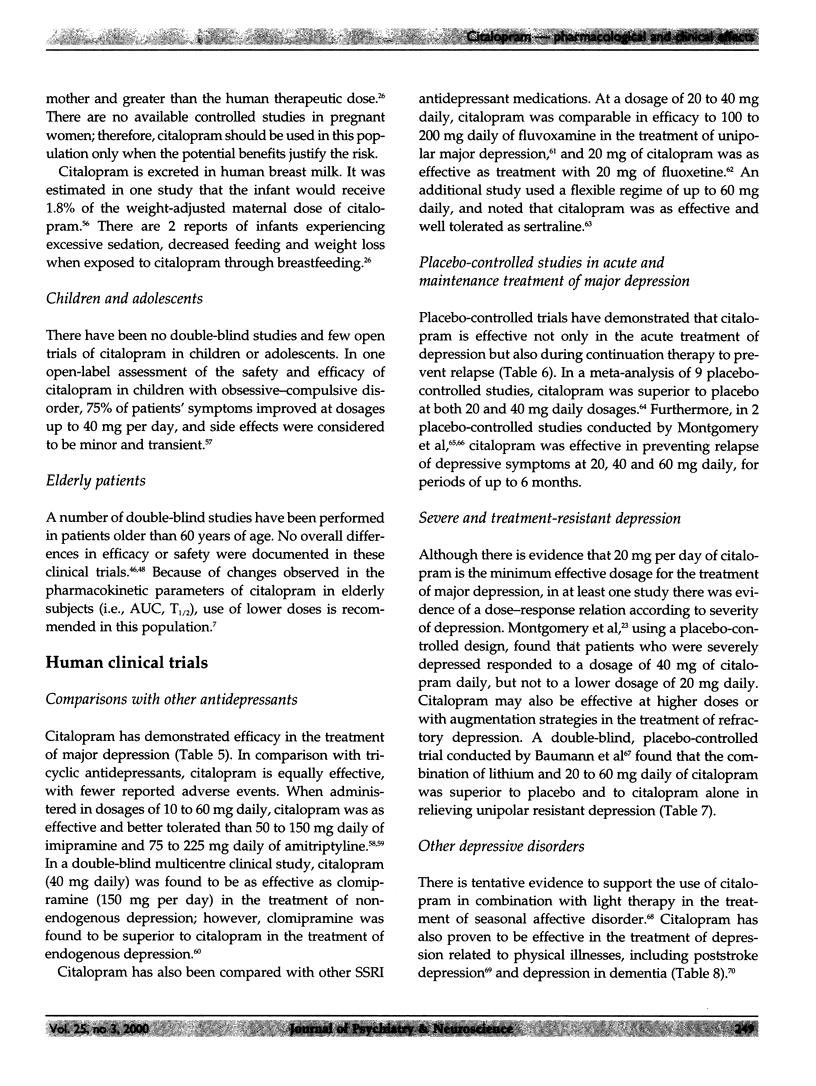
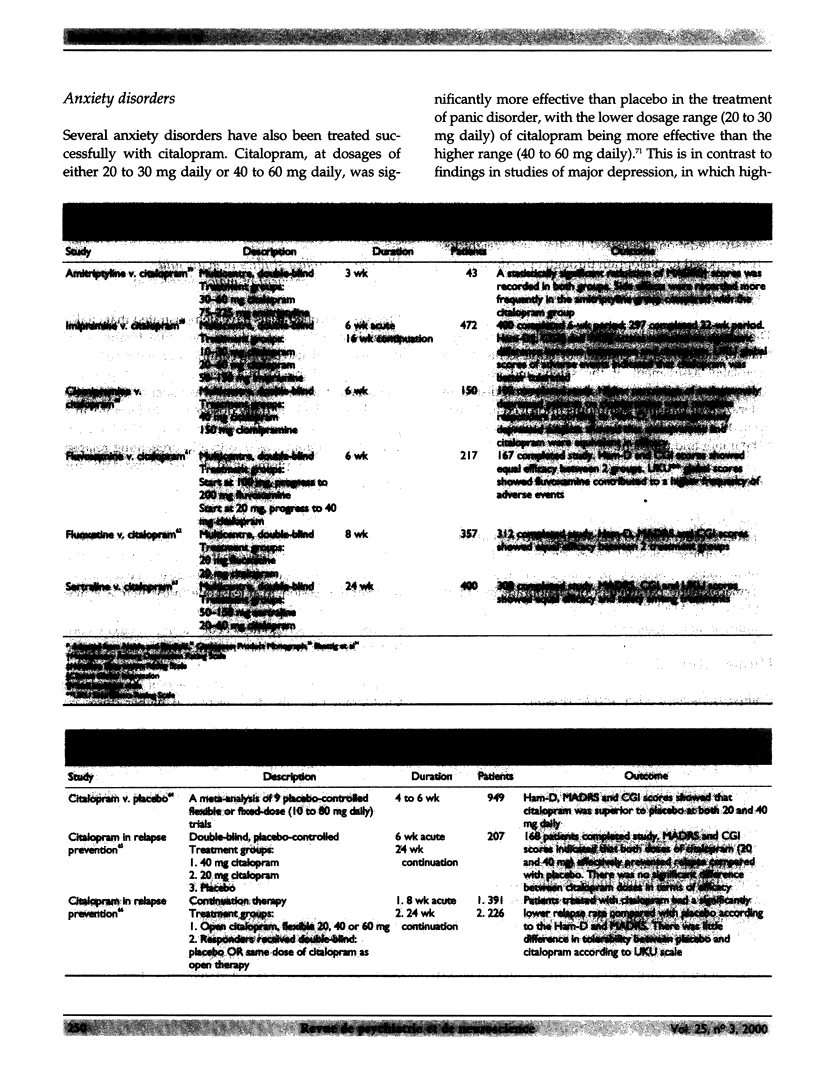
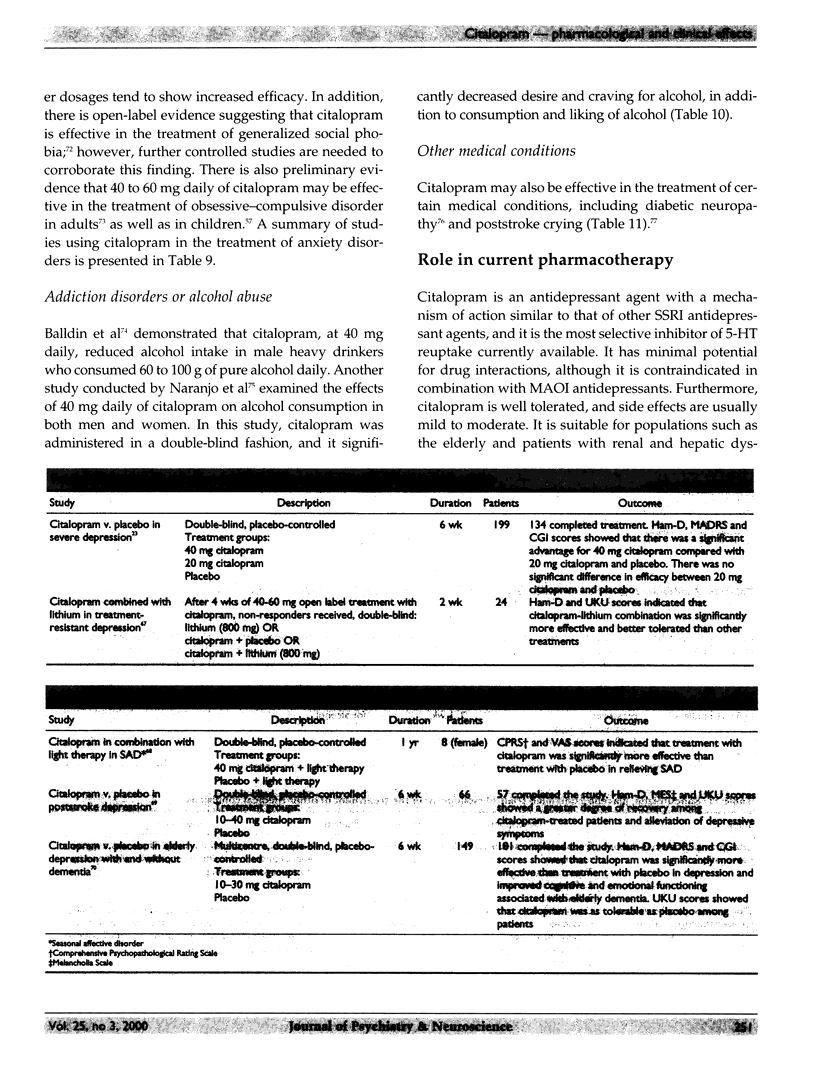
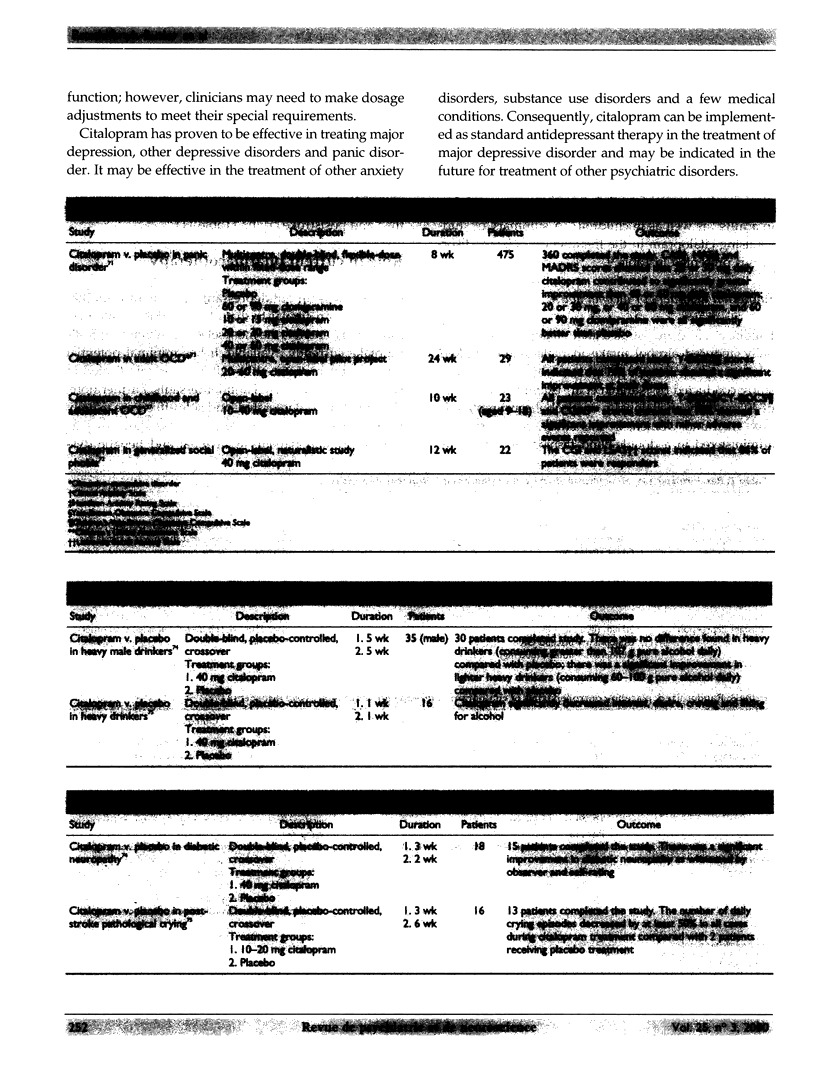
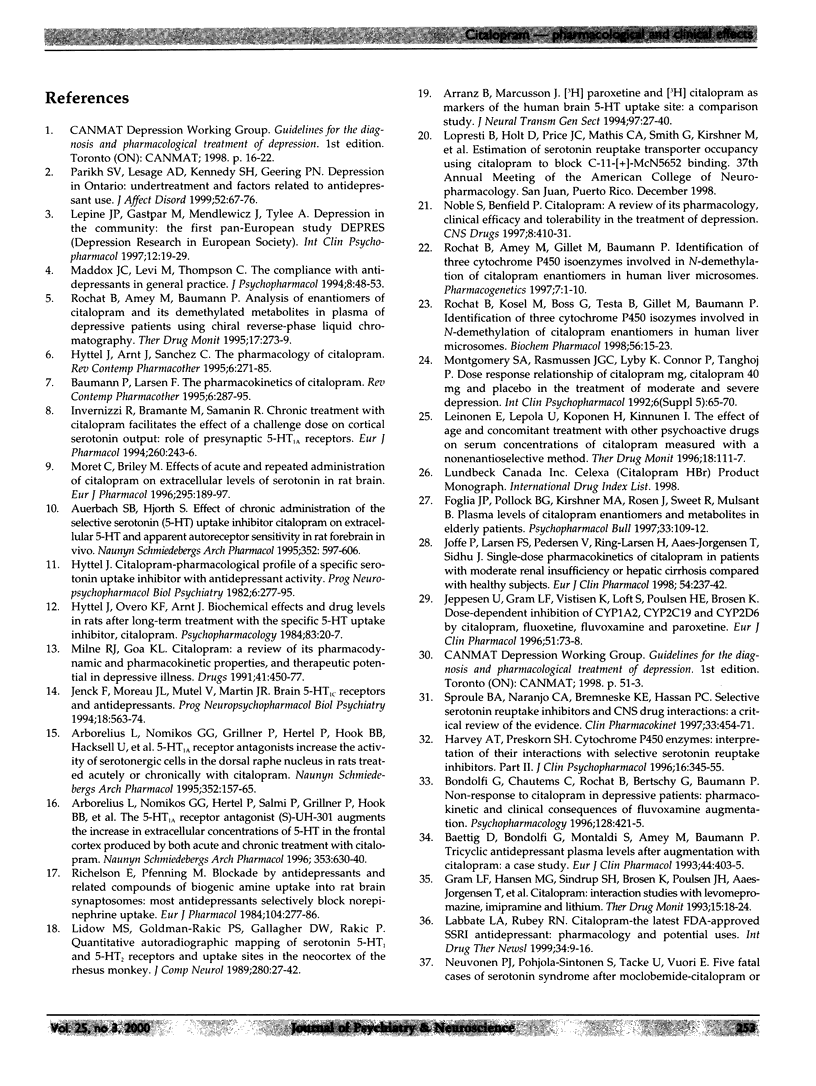

Selected References
These references are in PubMed. This may not be the complete list of references from this article.
- Andersen G. Treatment of uncontrolled crying after stroke. Drugs Aging. 1995 Feb;6(2):105–111. doi: 10.2165/00002512-199506020-00003. [DOI] [PubMed] [Google Scholar]
- Andersen G., Vestergaard K., Lauritzen L. Effective treatment of poststroke depression with the selective serotonin reuptake inhibitor citalopram. Stroke. 1994 Jun;25(6):1099–1104. doi: 10.1161/01.str.25.6.1099. [DOI] [PubMed] [Google Scholar]
- Arborelius L., Nomikos G. G., Grillner P., Hertel P., Hök B. B., Hacksell U., Svensson T. H. 5-HT1A receptor antagonists increase the activity of serotonergic cells in the dorsal raphe nucleus in rats treated acutely or chronically with citalopram. Naunyn Schmiedebergs Arch Pharmacol. 1995 Aug;352(2):157–165. doi: 10.1007/BF00176769. [DOI] [PubMed] [Google Scholar]
- Arborelius L., Nomikos G. G., Hertel P., Salmi P., Grillner P., Hök B. B., Hacksell U., Svensson T. H. The 5-HT1A receptor antagonist (S)-UH-301 augments the increase in extracellular concentrations of 5-HT in the frontal cortex produced by both acute and chronic treatment with citalopram. Naunyn Schmiedebergs Arch Pharmacol. 1996 May;353(6):630–640. doi: 10.1007/BF00167182. [DOI] [PubMed] [Google Scholar]
- Arranz B., Marcusson J. [3H]paroxetine and [3H]citalopram as markers of the human brain 5-HT uptake site: a comparison study. J Neural Transm Gen Sect. 1994;97(1):27–40. doi: 10.1007/BF01277960. [DOI] [PubMed] [Google Scholar]
- Auerbach S. B., Hjorth S. Effect of chronic administration of the selective serotonin (5-HT) uptake inhibitor citalopram on extracellular 5-HT and apparent autoreceptor sensitivity in rat forebrain in vivo. Naunyn Schmiedebergs Arch Pharmacol. 1995 Dec;352(6):597–606. doi: 10.1007/BF00171317. [DOI] [PubMed] [Google Scholar]
- Baettig D., Bondolfi G., Montaldi S., Amey M., Baumann P. Tricyclic antidepressant plasma levels after augmentation with citalopram: a case study. Eur J Clin Pharmacol. 1993;44(4):403–405. doi: 10.1007/BF00316483. [DOI] [PubMed] [Google Scholar]
- Balldin J., Berggren U., Engel J., Eriksson M., Hård E., Söderpalm B. Effect of citalopram on alcohol intake in heavy drinkers. Alcohol Clin Exp Res. 1994 Oct;18(5):1133–1136. doi: 10.1111/j.1530-0277.1994.tb00093.x. [DOI] [PubMed] [Google Scholar]
- Barbey J. T., Roose S. P. SSRI safety in overdose. J Clin Psychiatry. 1998;59 (Suppl 15):42–48. [PubMed] [Google Scholar]
- Baumann P., Nil R., Souche A., Montaldi S., Baettig D., Lambert S., Uehlinger C., Kasas A., Amey M., Jonzier-Perey M. A double-blind, placebo-controlled study of citalopram with and without lithium in the treatment of therapy-resistant depressive patients: a clinical, pharmacokinetic, and pharmacogenetic investigation. J Clin Psychopharmacol. 1996 Aug;16(4):307–314. doi: 10.1097/00004714-199608000-00006. [DOI] [PubMed] [Google Scholar]
- Baumann P. Pharmacokinetic-pharmacodynamic relationship of the selective serotonin reuptake inhibitors. Clin Pharmacokinet. 1996 Dec;31(6):444–469. doi: 10.2165/00003088-199631060-00004. [DOI] [PubMed] [Google Scholar]
- Berk M., Acton M. Citalopram-associated clitoral priapism: a case series. Int Clin Psychopharmacol. 1997 Mar;12(2):121–122. doi: 10.1097/00004850-199703000-00008. [DOI] [PubMed] [Google Scholar]
- Bondolfi G., Chautems C., Rochat B., Bertschy G., Baumann P. Non-response to citalopram in depressive patients: pharmacokinetic and clinical consequences of a fluvoxamine augmentation. Psychopharmacology (Berl) 1996 Dec;128(4):421–425. doi: 10.1007/s002130050152. [DOI] [PubMed] [Google Scholar]
- Bouwer C. D., Harvey B. H. Phasic craving for carbohydrate observed with citalopram. Int Clin Psychopharmacol. 1996 Dec;11(4):273–278. doi: 10.1097/00004850-199612000-00009. [DOI] [PubMed] [Google Scholar]
- Bouwer C., Stein D. J. Use of the selective serotonin reuptake inhibitor citalopram in the treatment of generalized social phobia. J Affect Disord. 1998 Apr;49(1):79–82. doi: 10.1016/s0165-0327(97)00182-1. [DOI] [PubMed] [Google Scholar]
- Ekselius L., von Knorring L., Eberhard G. A double-blind multicenter trial comparing sertraline and citalopram in patients with major depression treated in general practice. Int Clin Psychopharmacol. 1997 Nov;12(6):323–331. doi: 10.1097/00004850-199711000-00005. [DOI] [PubMed] [Google Scholar]
- Foglia J. P., Pollock B. G., Kirshner M. A., Rosen J., Sweet R., Mulsant B. Plasma levels of citalopram enantiomers and metabolites in elderly patients. Psychopharmacol Bull. 1997;33(1):109–112. [PubMed] [Google Scholar]
- Gottfries C. G., Karlsson I., Nyth A. L. Treatment of depression in elderly patients with and without dementia disorders. Int Clin Psychopharmacol. 1992 Jun;6 (Suppl 5):55–64. doi: 10.1097/00004850-199206005-00006. [DOI] [PubMed] [Google Scholar]
- Gram L. F., Hansen M. G., Sindrup S. H., Brøsen K., Poulsen J. H., Aaes-Jørgensen T., Overø K. F. Citalopram: interaction studies with levomepromazine, imipramine, and lithium. Ther Drug Monit. 1993 Feb;15(1):18–24. [PubMed] [Google Scholar]
- Gravem A., Amthor K. F., Astrup C., Elgen K., Gjessing L. R., Gunby B., Pettersen R. D., Kyrdalen L., Vaadal J., Ofsti E. A double-blind comparison of citalopram (Lu 10-171) and amitriptyline in depressed patients. Acta Psychiatr Scand. 1987 May;75(5):478–486. doi: 10.1111/j.1600-0447.1987.tb02821.x. [DOI] [PubMed] [Google Scholar]
- Haffmans P. M., Timmerman L., Hoogduin C. A. Efficacy and tolerability of citalopram in comparison with fluvoxamine in depressed outpatients: a double-blind, multicentre study. The LUCIFER Group. Int Clin Psychopharmacol. 1996 Sep;11(3):157–164. doi: 10.1097/00004850-199609000-00002. [DOI] [PubMed] [Google Scholar]
- Harvey A. T., Preskorn S. H. Cytochrome P450 enzymes: interpretation of their interactions with selective serotonin reuptake inhibitors. Part II. J Clin Psychopharmacol. 1996 Oct;16(5):345–355. doi: 10.1097/00004714-199610000-00002. [DOI] [PubMed] [Google Scholar]
- Hyttel J. Citalopram--pharmacological profile of a specific serotonin uptake inhibitor with antidepressant activity. Prog Neuropsychopharmacol Biol Psychiatry. 1982;6(3):277–295. doi: 10.1016/s0278-5846(82)80179-6. [DOI] [PubMed] [Google Scholar]
- Hyttel J., Overø K. F., Arnt J. Biochemical effects and drug levels in rats after long-term treatment with the specific 5-HT-uptake inhibitor, citalopram. Psychopharmacology (Berl) 1984;83(1):20–27. doi: 10.1007/BF00427416. [DOI] [PubMed] [Google Scholar]
- Invernizzi R., Bramante M., Samanin R. Chronic treatment with citalopram facilitates the effect of a challenge dose on cortical serotonin output: role of presynaptic 5-HT1A receptors. Eur J Pharmacol. 1994 Aug 1;260(2-3):243–246. doi: 10.1016/0014-2999(94)90344-1. [DOI] [PubMed] [Google Scholar]
- Jenck F., Moreau J. L., Mutel V., Martin J. R. Brain 5-HT1C receptors and antidepressants. Prog Neuropsychopharmacol Biol Psychiatry. 1994 May;18(3):563–574. doi: 10.1016/0278-5846(94)90013-2. [DOI] [PubMed] [Google Scholar]
- Jeppesen U., Gram L. F., Vistisen K., Loft S., Poulsen H. E., Brøsen K. Dose-dependent inhibition of CYP1A2, CYP2C19 and CYP2D6 by citalopram, fluoxetine, fluvoxamine and paroxetine. Eur J Clin Pharmacol. 1996;51(1):73–78. doi: 10.1007/s002280050163. [DOI] [PubMed] [Google Scholar]
- Koponen H., Lepola U., Leinonen E., Jokinen R., Penttinen J., Turtonen J. Citalopram in the treatment of obsessive-compulsive disorder: an open pilot study. Acta Psychiatr Scand. 1997 Nov;96(5):343–346. doi: 10.1111/j.1600-0447.1997.tb09927.x. [DOI] [PubMed] [Google Scholar]
- Laine K., Anttila M., Heinonen E., Helminen A., Huupponen R., Mäki-Ikola O., Reinikainen K., Scheinin M. Lack of adverse interactions between concomitantly administered selegiline and citalopram. Clin Neuropharmacol. 1997 Oct;20(5):419–433. doi: 10.1097/00002826-199710000-00006. [DOI] [PubMed] [Google Scholar]
- Leinonen E., Lepola U., Koponen H., Kinnunen I. The effect of age and concomitant treatment with other psychoactive drugs on serum concentrations of citalopram measured with a nonenantioselective method. Ther Drug Monit. 1996 Apr;18(2):111–117. doi: 10.1097/00007691-199604000-00001. [DOI] [PubMed] [Google Scholar]
- Leinonen E., Lepola U., Koponen H. Substituting carbamazepine with oxcarbazepine increases citalopram levels. A report on two cases. Pharmacopsychiatry. 1996 Jul;29(4):156–158. doi: 10.1055/s-2007-979563. [DOI] [PubMed] [Google Scholar]
- Lidow M. S., Goldman-Rakic P. S., Gallager D. W., Rakic P. Quantitative autoradiographic mapping of serotonin 5-HT1 and 5-HT2 receptors and uptake sites in the neocortex of the rhesus monkey. J Comp Neurol. 1989 Feb 1;280(1):27–42. doi: 10.1002/cne.902800104. [DOI] [PubMed] [Google Scholar]
- Lépine J. P., Gastpar M., Mendlewicz J., Tylee A. Depression in the community: the first pan-European study DEPRES (Depression Research in European Society). Int Clin Psychopharmacol. 1997 Jan;12(1):19–29. [PubMed] [Google Scholar]
- Milne R. J., Goa K. L. Citalopram. A review of its pharmacodynamic and pharmacokinetic properties, and therapeutic potential in depressive illness. Drugs. 1991 Mar;41(3):450–477. doi: 10.2165/00003495-199141030-00008. [DOI] [PubMed] [Google Scholar]
- Montgomery S. A., Pedersen V., Tanghøj P., Rasmussen C., Rioux P. The optimal dosing regimen for citalopram--a meta-analysis of nine placebo-controlled studies. Int Clin Psychopharmacol. 1994 Mar;9 (Suppl 1):35–40. doi: 10.1097/00004850-199403001-00006. [DOI] [PubMed] [Google Scholar]
- Montgomery S. A., Rasmussen J. G., Lyby K., Connor P., Tanghøj P. Dose response relationship of citalopram 20 mg, citalopram 40 mg and placebo in the treatment of moderate and severe depression. Int Clin Psychopharmacol. 1992 Jun;6 (Suppl 5):65–70. doi: 10.1097/00004850-199206005-00007. [DOI] [PubMed] [Google Scholar]
- Montgomery S. A., Rasmussen J. G., Tanghøj P. A 24-week study of 20 mg citalopram, 40 mg citalopram, and placebo in the prevention of relapse of major depression. Int Clin Psychopharmacol. 1993 Fall;8(3):181–188. doi: 10.1097/00004850-199300830-00008. [DOI] [PubMed] [Google Scholar]
- Moret C., Briley M. Effects of acute and repeated administration of citalopram on extracellular levels of serotonin in rat brain. Eur J Pharmacol. 1996 Jan 11;295(2-3):189–197. doi: 10.1016/0014-2999(95)00646-x. [DOI] [PubMed] [Google Scholar]
- Muldoon C. The safety and tolerability of citalopram. Int Clin Psychopharmacol. 1996 Mar;11 (Suppl 1):35–40. doi: 10.1097/00004850-199603001-00007. [DOI] [PubMed] [Google Scholar]
- Naranjo C. A., Poulos C. X., Bremner K. E., Lanctôt K. L. Citalopram decreases desirability, liking, and consumption of alcohol in alcohol-dependent drinkers. Clin Pharmacol Ther. 1992 Jun;51(6):729–739. doi: 10.1038/clpt.1992.85. [DOI] [PubMed] [Google Scholar]
- Nyth A. L., Gottfries C. G. The clinical efficacy of citalopram in treatment of emotional disturbances in dementia disorders. A Nordic multicentre study. Br J Psychiatry. 1990 Dec;157:894–901. doi: 10.1192/bjp.157.6.894. [DOI] [PubMed] [Google Scholar]
- Parikh S. V., Lesage A. D., Kennedy S. H., Goering P. N. Depression in Ontario: under-treatment and factors related to antidepressant use. J Affect Disord. 1999 Jan-Mar;52(1-3):67–76. doi: 10.1016/s0165-0327(98)00063-9. [DOI] [PubMed] [Google Scholar]
- Patris M., Bouchard J. M., Bougerol T., Charbonnier J. F., Chevalier J. F., Clerc G., Cyran C., Van Amerongen P., Lemming O., Høpfner Petersen H. E. Citalopram versus fluoxetine: a double-blind, controlled, multicentre, phase III trial in patients with unipolar major depression treated in general practice. Int Clin Psychopharmacol. 1996 Jun;11(2):129–136. [PubMed] [Google Scholar]
- Personne M., Persson H., Sjöberg E. Citalopram toxicity. Lancet. 1997 Aug 16;350(9076):518–519. doi: 10.1016/s0140-6736(05)63109-1. [DOI] [PubMed] [Google Scholar]
- Priskorn M., Sidhu J. S., Larsen F., Davis J. D., Khan A. Z., Rolan P. E. Investigation of multiple dose citalopram on the pharmacokinetics and pharmacodynamics of racemic warfarin. Br J Clin Pharmacol. 1997 Aug;44(2):199–202. doi: 10.1046/j.1365-2125.1997.00628.x. [DOI] [PMC free article] [PubMed] [Google Scholar]
- Richelson E., Pfenning M. Blockade by antidepressants and related compounds of biogenic amine uptake into rat brain synaptosomes: most antidepressants selectively block norepinephrine uptake. Eur J Pharmacol. 1984 Sep 17;104(3-4):277–286. doi: 10.1016/0014-2999(84)90403-5. [DOI] [PubMed] [Google Scholar]
- Robert P., Montgomery S. A. Citalopram in doses of 20-60 mg is effective in depression relapse prevention: a placebo-controlled 6 month study. Int Clin Psychopharmacol. 1995 Mar;10 (Suppl 1):29–35. [PubMed] [Google Scholar]
- Rochat B., Amey M., Baumann P. Analysis of enantiomers of citalopram and its demethylated metabolites in plasma of depressive patients using chiral reverse-phase liquid chromatography. Ther Drug Monit. 1995 Jun;17(3):273–279. doi: 10.1097/00007691-199506000-00011. [DOI] [PubMed] [Google Scholar]
- Rochat B., Amey M., Gillet M., Meyer U. A., Baumann P. Identification of three cytochrome P450 isozymes involved in N-demethylation of citalopram enantiomers in human liver microsomes. Pharmacogenetics. 1997 Feb;7(1):1–10. doi: 10.1097/00008571-199702000-00001. [DOI] [PubMed] [Google Scholar]
- Rochat B., Kosel M., Boss G., Testa B., Gillet M., Baumann P. Stereoselective biotransformation of the selective serotonin reuptake inhibitor citalopram and its demethylated metabolites by monoamine oxidases in human liver. Biochem Pharmacol. 1998 Jul 1;56(1):15–23. doi: 10.1016/s0006-2952(98)00008-2. [DOI] [PubMed] [Google Scholar]
- Rosenbaum J. F., Fava M., Hoog S. L., Ascroft R. C., Krebs W. B. Selective serotonin reuptake inhibitor discontinuation syndrome: a randomized clinical trial. Biol Psychiatry. 1998 Jul 15;44(2):77–87. doi: 10.1016/s0006-3223(98)00126-7. [DOI] [PubMed] [Google Scholar]
- Rosenberg C., Damsbo N., Fuglum E., Jacobsen L. V., Horsgård S. Citalopram and imipramine in the treatment of depressive patients in general practice. A Nordic multicentre clinical study. Int Clin Psychopharmacol. 1994 Mar;9 (Suppl 1):41–48. doi: 10.1097/00004850-199403001-00007. [DOI] [PubMed] [Google Scholar]
- Segraves R. T. Antidepressant-induced sexual dysfunction. J Clin Psychiatry. 1998;59 (Suppl 4):48–54. [PubMed] [Google Scholar]
- Sindrup S. H., Bjerre U., Dejgaard A., Brøsen K., Aaes-Jørgensen T., Gram L. F. The selective serotonin reuptake inhibitor citalopram relieves the symptoms of diabetic neuropathy. Clin Pharmacol Ther. 1992 Nov;52(5):547–552. doi: 10.1038/clpt.1992.183. [DOI] [PubMed] [Google Scholar]
- Spigset O., Adielsson G. Combined serotonin syndrome and hyponatraemia caused by a citalopram-buspirone interaction. Int Clin Psychopharmacol. 1997 Jan;12(1):61–63. doi: 10.1097/00004850-199701000-00010. [DOI] [PubMed] [Google Scholar]
- Spigset O., Carieborg L., Ohman R., Norström A. Excretion of citalopram in breast milk. Br J Clin Pharmacol. 1997 Sep;44(3):295–298. doi: 10.1046/j.1365-2125.1997.t01-1-00576.x. [DOI] [PMC free article] [PubMed] [Google Scholar]
- Sproule B. A., Naranjo C. A., Brenmer K. E., Hassan P. C. Selective serotonin reuptake inhibitors and CNS drug interactions. A critical review of the evidence. Clin Pharmacokinet. 1997 Dec;33(6):454–471. doi: 10.2165/00003088-199733060-00004. [DOI] [PubMed] [Google Scholar]
- Syvälahti E. K., Taiminen T., Saarijärvi S., Lehto H., Niemi H., Ahola V., Dahl M. L., Salokangas R. K. Citalopram causes no significant alterations in plasma neuroleptic levels in schizophrenic patients. J Int Med Res. 1997 Jan-Feb;25(1):24–32. doi: 10.1177/030006059702500104. [DOI] [PubMed] [Google Scholar]
- Taylor D., Ellison Z., Ementon Shaw L., Wickham H., Murray R. Co-administration of citalopram and clozapine: effect on plasma clozapine levels. Int Clin Psychopharmacol. 1998 Jan;13(1):19–21. doi: 10.1097/00004850-199801000-00003. [DOI] [PubMed] [Google Scholar]
- Thomsen P. H. Child and adolescent obsessive-compulsive disorder treated with citalopram: findings from an open trial of 23 cases. J Child Adolesc Psychopharmacol. 1997;7(3):157–166. doi: 10.1089/cap.1997.7.157. [DOI] [PubMed] [Google Scholar]
- Wade A. G., Lepola U., Koponen H. J., Pedersen V., Pedersen T. The effect of citalopram in panic disorder. Br J Psychiatry. 1997 Jun;170:549–553. doi: 10.1192/bjp.170.6.549. [DOI] [PubMed] [Google Scholar]


